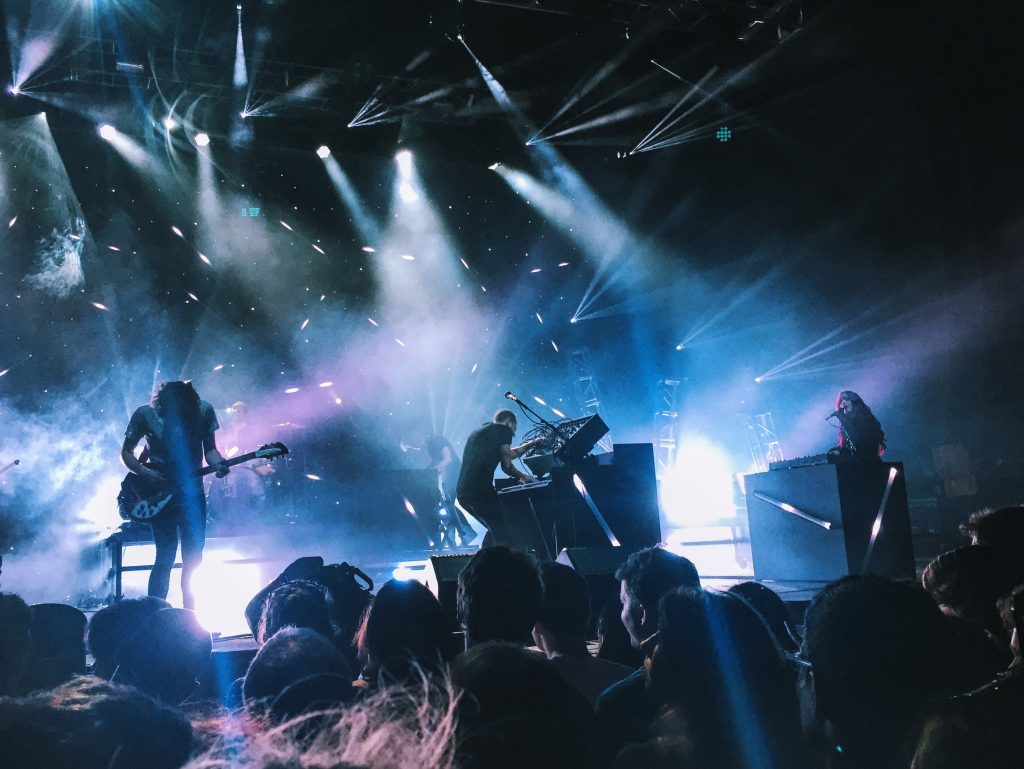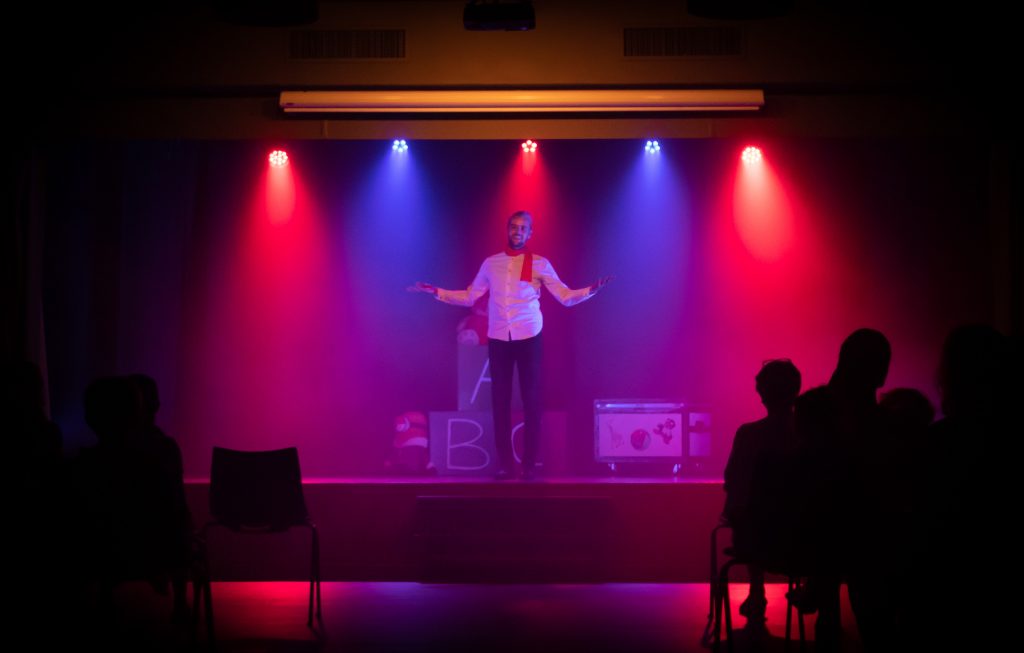The star-studded entertainment industry is in a class of its own — that means a regular ol’ digital marketing plan simply won’t cut it. Here’s how to create one that’ll bring you show-stopping results.
Here, you’ll find:
- What makes entertainment marketing different
- Elements of a successful marketing plan for this industry
- How to create a versatile buyer persona (and why you should)
- Why creating an omnichannel experience is key
From DJs and film production companies to theaters, amusement parks and everything in between, businesses in the entertainment industry require a special approach to marketing.
Sure, competition can be fierce and clients can be demanding. But there’s also a ton of potential when it comes to marketing, and more opportunities for fun, outside-the-box campaigns compared to more traditional or buttoned-up brands.
Building an effective digital marketing plan for an entertainment company requires industry knowledge, a clear understanding of your audience, and a firm grasp on your ultimate goal.
Let’s take a look at creating a successful strategy for your entertainment business.
Programming note: This article will cover how to create a digital marketing plan fit for an entertainment-related brand, not product placement in entertainment (like characters drinking a particular soda in TV shows).

In the entertainment industry, trends play a major role in the entire marketing strategy. (Image: Unsplash)
What makes entertainment industry marketing different?
When designing your entertainment marketing plan, you can start with a generic framework that applies to most businesses. Think: the common pillars like an SEO strategy, paid search campaigns, and all that jazz.
But if you want to see significant ROI and visibility on the search engine results page (SERP), both paid and organic, you’ve got to take things a step further. That means considering the unique aspects of the entertainment field, particularly your specific niche. (After all, a casino is likely going to market itself differently than a children’s magician.)
The key differences in entertainment marketing include:
Fast-changing content
In the entertainment industry, trends play a major role in the entire marketing strategy. Much of the marketing content created for entertainment brands is time-sensitive, meaning you’ve got a limited time to make an impact.
To compete, you need to stay on top of the latest trends and generate relevant content on a regular basis.
Specific audience segments
Fans are the entertainment industry’s driving force. They’re the ones who can use word of mouth to spread your marketing message further than you could yourself.
Fans are devoted. That means you need to connect with them authentically and in a way that illustrates you respect their dedication. Fans love easter egg-type messaging and inside jokes, so you can play these up when you’re creating your marketing strategy.
Want vs. need
At the end of the day, people spend money on entertainment because they like it, not because they need it.
For example, let’s say someone loves fantasy football. Can they live a normal life without it? Of course.
That’s quite different from a dentist’s buyer persona whose quality of life may decrease if they don’t use the provided services.
As a result, entertainment marketing often focuses on “want points” rather than on real “pain points.” This can make it trickier to push customers down the sales funnel, but it can be done if you amp up the “fun” and “delight” factors.
Dynamic data
Shifting trends in your respective entertainment genre could steal your existing audience or bring new segments into the picture.
Think about back in 2020, when major motion picture studios had to majorly pivot their film release plans. Some pushed back release dates while others went straight to streaming because box offices couldn’t move tickets like they once did.
To combat this, it’s important to continuously collect and analyze data to make sure you aren’t spending your marketing budget on wrong or outdated tactics. Keeping tabs on your competition will also help you stay in the loop.

Take the time to review buyer personas and audience segments regularly so you don’t miss out on new opportunities. (Image: Unsplash)
8 expert tips for a successful entertainment marketing plan
Here’s a hard truth: the entertainment industry is still working to recover from the pandemic. The number of U.S.-based arts, entertainment, and recreation businesses went from 1.69 million in 2019 to less than 1.5 million in 2020 — a roughly 12% decline.
As these companies work to get back on their feet, a thoughtful marketing strategy can be a powerful force. Without a plan, it’s nearly impossible to achieve the desired results and avoid overspending.
#1 Identify (and segment) your target audience
Creating an effective buyer persona is one of the most crucial parts of building an entertainment marketing plan. But narrowing down your demographics can be challenging. Take video games, for example: While they may have had a rather niche audience a few decades ago, today’s gaming target audience spans regions, generations, income bracket, and more.
Most likely, you’ll end up creating several buyer personas. From there, you can build a few campaigns that target these different segments through keywords, ad copy, and landing pages. You can also speak to these segments through SEO tactics like content marketing and organic social posts.
Pro tip: Take the time to review buyer personas and audience segments regularly so you don’t miss out on new opportunities.
#2 Set SMART marketing goals
Once you know who you want to target, it’s time to pinpoint what it is you want from them and how you’ll measure success.
Setting goals and key performance indicators (KPIs) gives you something to strive for and measure against. Don’t get too in the weeds if you’re just starting out with goal setting for your digital marketing program: If it turns out your goal is way too easy or way out of reach, you can modify it for next time.
A SMART goal-setting system (which stands for specific, measurable, attainable, relevant, time-based) works great for entertainment marketing strategies.
Depending on your particular business and budget, your SMART marketing goals could be about achieving a goal by a certain percentage within a certain time frame, like increasing your clickthrough rate by 25% by the end of the quarter. Goals can pertain to various facets of your marketing program, such as:
- Bounce rate and time on page
- Website traffic
- Customer acquisition costs and cost per lead
- Ranking positions on the SERP
- Event RSVPs
Of course, your SMART goals may change throughout your company’s lifecycle. For example, your goals could shift from attracting new clients to improving retention rates. If you already have a SMART goal system implemented, it’ll be easier to adjust goals in the process.
#3 Invest in your website
Your website is your best bet to make a good first impression.
Even if you create a killer ad with effective copy, if you serve up a sub-par experience once someone lands on your landing page or elsewhere on your site? You’re probably not in the best place to hit those SMART goals we talked about earlier.
Whether you partner with an in-house designer, a freelancer, or an agency, investing in a high-quality, cohesive website design will pay off. Once you finalize aspects like preferred brand colors, fonts, and imagery, you can mirror these aesthetics in places like your social media, display ads, and collateral for a professional, consistent look.
Pro tip: Reviews and ratings are a significant part of entertainment SEO. Take the time to source them from your existing clients and implement them across different marketing channels.
#4 Leverage paid search ads
Good SEO is worth it, but it takes time to build. That’s why pairing it with an action-oriented pay-per-click (also called PPC or paid search) plan can help you garner more speedy results in the meantime.
Admittedly, we primarily mean the Google search engine when we talk about paid search. However, it’s certainly worth noting that paid search engine marketing can also include Bing Ads, social media ads, and e-commerce search engines like Amazon.
At a high level, a paid search strategy for an entertainment brand should include these steps:
- Keyword research to determine what terms your audience is using in search engine queries to find what you offer
- A bid strategy and makes sense for your goals and budget
- Targeted ads that lead to consistent, high-quality landing pages
- Concise calls to action (CTAs) to inspire the visitor to complete the desired action
- Thoughtful targeting parameters
- A negative keywords list to weed out unqualified clicks
- A plan for regular optimizing and monitoring so you can assess what’s working and what’s not
Of course, plenty more goes into a full paid search plan. Dig into the details on our blog, or — better yet — have us do all the work for you.

As an entertainment industry player, experimenting with an omnichannel experience can keep you top of mind and competitive. (Image: Unsplash)
#5 Cover all your SEO bases
We consider search engine optimization (SEO) to be made up of three factors:
- Onsite SEO (blogs, meta descriptions, page titles)
- Offsite SEO (Google Business Profile, third-party review sites, directory listings, backlinks)
- Technical SEO (structured data, site architecture, navigation, URL structures)
A strong SEO strategy is what’s going to help you surface in organic search results. It can also help you be seen as an authority and trusted resource in your niche.
The best way to gauge the current state of your SEO efforts is to conduct an SEO audit. From there, you can pinpoint strengths and weaknesses, and work to make sure your website, online presence overall, and your content are helping your brand build a strong search engine optimization practice.
Check out our step-by-step guide to SEO audit here.
And speaking of content…
#6 Create thoughtful, strategic content
A well-rounded digital marketing plan leverages both paid and organic efforts. The latter falls under the SEO umbrella, and a pillar of good SEO lies in content marketing.
Perhaps the tricky part about entertainment content is that it needs to be both valuable and entertaining itself. If someone searches for a topic related to your product or service, and the content they reach is a snooze? That’s not a good preview of coming attractions, let’s say.
It’s all about balancing the value (to provide information and education, usually) with a wow factor. Luckily, you have multiple platforms at your disposal to make this happen.
While many marketers go straight to thinking of blog posts when they hear “content,” this can mean so much more — especially in the entertainment realm.
Entertainment content marketing can look like:
- Social media posts
- Video content (short- and long-form, on your site as well as platforms like YouTube)
- Podcasts
- How-to e-books
- Downloadable templates
- And more
This industry also lends itself well to interactive content. As CoSchedule explains, “Interactive content marketing involves using content to engage your audience based on their participation. It’s kind of like a conversation, but one in which you don’t have to actively participate.“
It’s no surprise this content type resonates — interactive content is more engaging by nature. Examples of this content include a virtual-reality feature that lets people put themselves in an alternate universe, a sponsored personality quiz, or a visual offering movie or Netflix streaming suggestions based on a user’s past watch history.
Pro tip: Once you figure out what keywords to target and the content types you want to publish, create a content marketing calendar to keep it all organized. This will offer a zoomed-out view of your overall strategy, keep everyone on the same page, and offer accountability when it comes to who is responsible for what during the creation process.
#7 Use multiple channel advertising
Long gone are the days of giant cube-shaped TVs with a number of channels you could count on one hand.
These days, people can get their entertainment from several devices: smart TVs, mobile phones, tablets, gaming systems, the list goes on (and those are just the digital platforms).
As an entertainment industry player, experimenting with an omnichannel experience can keep you top of mind and competitive. It’s all about knowing where your audience “hangs out” in digital spaces.
While SEO and paid search tactics are sure to pay off, it could also be worth exploring additional channels such as:
- Mobile/text marketing
- In-game advertising
- Video marketing
- In-app ads
- Paid social opportunities
- Email marketing
Pro tip: If your business hinges on the “live” aspect, then focusing on local marketing is where it’s at. Take advantage of local SEO best practices as well as targeting local keywords in your ads to pinpoint the audience in your region effectively.
#8 Partner with influencers
Most marketing professionals should be familiar with the concept of influencers at this point. In a nutshell, influencer marketing is a partnership between a brand and a person or group who is considered influential in their industry or field.
Brands work with influencers to endorse, advocate, or otherwise spread the word about their brand, offering, or event.
Examples of influencer content include:
- Instagram photos or Stories
- Sponsored blog posts
- Tweets
- Facebook or LinkedIn statuses
- TikTok or YouTube videos
- And more
Nearly every person consumes some form of this medium. So, it’s no surprise that influencer partnerships can be an especially successful avenue for entertainment businesses to take advantage of, as nearly every single person consumes some form of this medium.
The influencer and campaign type you opt for will depend on a few factors, including your budget, what you’re promoting, and what platforms you want the influencer to post on.
Set yourself up for a successful partnership with our full guide to influencer marketing here.
#9 Host live events
The world is slowly opening back up after the pandemic rendered in-person events nearly nonexistent for years. With people feeling more comfortable attending IRL gatherings, entertainment businesses once again have the chance to host seminars, themed parties, pop-ups, and other live events.
Whether it’s an advanced film screening or a launch party for your latest product, hosting a live event that’ll benefit your marketing goals isn’t just about the food, drinks, and decor.
For your next event, consider creating a unique hashtag and setting up notifications for it so you can monitor (and potentially repurpose) any real-time user-generated content (UGC) from the event. You can also include an option for people to subscribe to your email marketing in the RSVP.
Pro tip: To be as accessible as possible and allocate for those who can’t or aren’t able to make a live event, consider a virtual event component or even a livestream option as well.
The takeaway
Whether your goal is as organic as brand awareness or as specific as hitting a certain number of site visits, there are measurable tactics you can use to build and refine a proper entertainment marketing plan.
Once you’ve got the pillars of your plan laid out, don’t be afraid to experiment, think outside the box, and have fun with your marketing campaigns — entertainment is about not taking yourself too seriously, right? That’s showbiz, baby!

